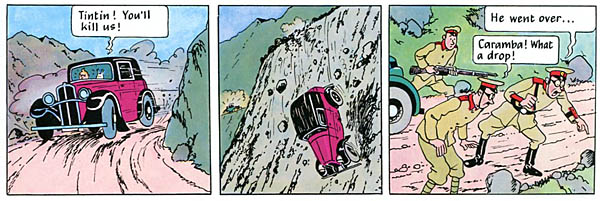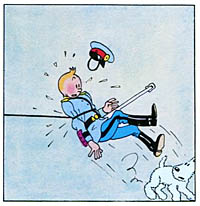 By Hergé
By Hergé
64 pages, color
Published by Little, Brown
I promised myself late last year, after reading Charles Burns’s X’ed Out, that I would make 2011 the year that I finally sat down and read the collection of Tintin albums that I got for a steal back in the day, but had never actually gotten around to starting. It’s a rather obvious omission in my comic reading vocabulary (despite growing up reading a friend’s Asterix books, but never trying the Tintin books sitting right next to them), and it’s been an interesting process going through them in order. With Tintin and the Broken Ear, the sixth book from Hergé, I’m happy to say that I feel like I’ve finally gotten far enough in that I can see what all the fuss is about.
In the three books I’d read before this one (Tintin in America, Cigars of the Pharaoh, and The Blue Lotus) it was hard to keep from feeling like Tintin ultimately solved his mysteries and stopped the bad guys out of sheer luck, rather than any particular skill on our hero’s part. Things seemed to just fall into place for him, and at times even wrapped themselves up despite his presence rather than because of it. Clearly as Hergé continued to work on the Tintin series, though, his skills continued to evolve, and Tintin and the Broken Ear is the point where it finally clicks into place.

It helps that the initial plot is fairly simple, with a South American idol with a broken ear going missing at the museum, only to be replaced with a replica that has an undamaged ear. Intrigued, both Tintin and several criminals start trying to track down the original idol, and in the process end up in all sorts of bad situations. Unlike earlier albums, each new and strange setting actually fits with the previous one. So while you might not expect to hit the halfway point and find Tintin the colonel of a local army, it doesn’t feel like it’s come entirely out of the blue. Instead you can trace his process from start to finish, and throughout the entire book Tintin doesn’t lose sight of his goals. It’s also a book where good deeds ultimately pay off in the long run, and Tintin himself has become a strong and likable character. Perhaps because he’s not just stumbling through his , and while the settings of the book continue to grow and expand, the foes of the book don’t come out of the blue for an 11th hour surprise like in some of the earlier stories; we know who Tintin’s going up against from the first few pages, and they become a constant nemesis until the grand conclusion. Hergé has also by this point in his career started to shed some of his earlier views on non-European nations. There’s much less of the speaking down to these countries that punctuated his earlier books, and while there’s still a certain "you’re in the rough parts of the world now, Tintin" voice still prevailing, the story (save for a truly unfortunate disguise involving blackface that made my jaw drop) feels much more contemporary in terms of its attitudes.
 While this was the first Tintin book where I felt like the writing was finally up to snuff, though, Hergé’s art has remained a constant in terms of strength. (It admittedly helps that Hergé went back and redrew portions of the first handful of books in the 1940s when they were edited down to a uniform 62-page length.) It’s such a simple style, but it remains attractive the whole way through. Just look at how he draws characters moving, from Tintin running down a flight of stairs to getting lassoed. They look almost like they’re animated, and that at any given moment you’ll actually see them start moving instead of being a frozen image. Ethnic characters are still drawn stereotypically (from the big bushy mustaches on many of the Latin American characters, and the already mentioned blackface moment is rather appalling), but at least it’s not as prevalent as it was in the earlier volumes. Instead we get (especially in the second half) beautiful mountain roads, snazzy cars, and dangerous waterfalls. Once the book enters the wilderness it’s as if Hergé was just waiting to cut loose, artistically. Later editions of the Tintin books are in smaller-dimensioned 3-in-1 editions, but I can’t imagine wanting to see this art shrunken down at all. The characters might look simple, but they’re deceptively expressive and I think it would get lost in a smaller size.
While this was the first Tintin book where I felt like the writing was finally up to snuff, though, Hergé’s art has remained a constant in terms of strength. (It admittedly helps that Hergé went back and redrew portions of the first handful of books in the 1940s when they were edited down to a uniform 62-page length.) It’s such a simple style, but it remains attractive the whole way through. Just look at how he draws characters moving, from Tintin running down a flight of stairs to getting lassoed. They look almost like they’re animated, and that at any given moment you’ll actually see them start moving instead of being a frozen image. Ethnic characters are still drawn stereotypically (from the big bushy mustaches on many of the Latin American characters, and the already mentioned blackface moment is rather appalling), but at least it’s not as prevalent as it was in the earlier volumes. Instead we get (especially in the second half) beautiful mountain roads, snazzy cars, and dangerous waterfalls. Once the book enters the wilderness it’s as if Hergé was just waiting to cut loose, artistically. Later editions of the Tintin books are in smaller-dimensioned 3-in-1 editions, but I can’t imagine wanting to see this art shrunken down at all. The characters might look simple, but they’re deceptively expressive and I think it would get lost in a smaller size.
Tintin and the Broken Ear was to be my turning point to see if I was going to keep reading, but it passed that test rather well. While it still hasn’t hit, "I absolutely must read all the rest of the books right now!" levels, it’s proving to be consistent entertainment. And knowing that I’ve still got seventeen more volumes to go in which Hergé gets to keep improving his craft? Well, if the leaps and bounds like I saw in the earlier volumes continue, it’s becoming increasingly obvious why Hergé’s character is such an icon. I’m on board for much more to come.
Purchase Links: Amazon.com | Powell’s Books
